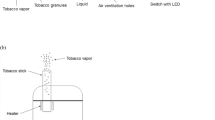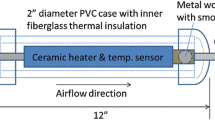Abstract
Cigarette smokers have a wide variety of “tar” and nicotine yields to choose from in the current market, ranging from 0.5 mg “tar” and less than 0.05 mg nicotine to 27 mg “tar” and 1.8 mg nicotine by the Federal Trade Commission (FTC) method. To understand better the relationship between FTC nicotine yields and actual nicotine uptake in smokers, we have studied nicotine uptake in 33 smokers of self-selected products representing four “tar” groupings: 1 mg “tar” (1 MG), ultra-low “tar” (ULT), full-flavor low “tar” (FFLT), and full flavor (FF) cigarettes. These cigarette categories had mean FTC nicotine yields of 0.14, 0.49, 0.67, and 1.13 mg/cigarette, respectively. The subjects smoked their usual brand of cigarette ad libitum and provided a 24-h urine sample for total nicotine uptake analysis over a period during which the number of cigarettes smoked was recorded. Nicotine uptake was determined by monitoring urinary nicotine and its metabolites, including the glucuronide conjugates. Daily nicotine uptake was 9.1±7.3 mg (range 1–21 mg) for 1 MG, 19.2±10.0 mg (range 4–42 mg) for ULT, 21.8±9.4 mg (range 13–38 mg) for FFLT, and 37.1±14.4 mg (range 21–60 mg) for FF smokers. On a per cigarette basis, yields were 0.23±0.11, 0.56±0.23, 0.60±0.18, and 1.19±0.43 mg nicotine, respectively. Although individual variability was fairly large (CVs of 0.39–0.80), means for the different groups showed that lower FTC yield smokers not only absorb less nicotine per 24-h period, but also per cigarette smoked. These data suggest that nicotine uptake is a function of individual smoking behavior within product design limits. We conclude from these data that, while FTC yield cannot precisely predict nicotine uptake for an individual smoker, it is useful in predicting and comparing actual nicotine uptake by smokers who select cigarettes with a particular FTC yield.
Similar content being viewed by others
References
Ashton H, Stepney R, Thompson JW (1979) Self titration by cigarette smokers. BMJ 2:357–360
Benowitz NL (1988a) Pharmacokinetics and pharmacodynamics of nicotine. In: Rand MJ, Thurau K (eds) The pharmacology of nicotine IRL Press, Oxford, Washington
Benowitz NL (1988b) Pharmacological aspects of cigarette smoking and nicotine addiction. N Engl J Med 319:1318–1330
Benowitz NL (1991) Metabolism in the human biology of nicotine. In: Adlkofer F, Thurau K (eds) Effects of nicotine on biological systems. Birkhäuser Verlag, Basel
Benowitz NL, Jacob P (1984a) Nicotine and carbon monoxide intake from high-and low-yield cigarettes. Clin Pharmacol Ther 36:264–270
Benowitz NL, Jacob P (1984b) Daily intake of nicotine during cigarette smoking. Clin Pharmacol Ther 35:499–504
Benowitz NL, Jacob P, Jones RT, Rosenberg J (1982) Inter-individual variability in the metabolism and cardiovascular effects of nicotine in man. J Pharmacol Exp Ther 221:368–372
Benowitz NL, Hall SM, Herning RI, Jacob P, Jones RT, Osman AL (1983) Smokers of low-yield cigarettes do not consume less nicotine. N Engl J Med 309:139–142
Benowitz NL, Jacob P, Kozlowski LT, Yu L (1986a) Influence of smoking fewer cigarettes on exposure to tar, nicotine, and carbon monoxide. N Engl J Med 315:1310–1313
Benowitz NL, Jacob P, Yu L, Talcott R, Hall S, Jones RT (1986b) Reduced tar, nicotine, and carbon monoxide exposure while smoking ultralow- but not low-yield cigarettes. JAMA 256:241–246
Benowitz NL, Jacob P, Denaro C, Jenkins R (1991) Stable isotope studies of nicotine kinetics and bioavailability. Clin Pharmacol Ther 49:270–277
Benowitz NL, Jacob P, Fong I, Gupta S (1994) Nicotine metabolic profile in man: comparison of cigarette smoking and transdermal nicotine. J Pharmacol Exp Ther 268:296–303
Bridges RB, Combs JG, Humble JW, Turbek JA, Rehm SR, Haley NJ (1990) Puffing topography as a determination of smoke exposure. Pharmacol Biochem Behav 37:29–39
Byrd GD (1993) Comparison of GC/MS and LC/MS methods for determining nicotine absorption in tobacco smokers. 41 st ASMS Conference on Mass Spectrometry and Allied Topics, San Francisco, Calif.
Byrd GD, Chang KM, Greene JM, deBethizy JD (1992) Evidence for urinary excretion of glucuronide conjugates of nicotine, cotinine, andtrans-3′-hydroxycotinine in smokers. Drug Meta Dispos 20:192–197
Byrd GD, Uhrig MS, deBethizy JD, Caldwell WS, Crooks PA, Ravard A, Riggs RM (1994) Direct determination of cotinine-N-glucuronide in urine using thermospray liquid chromatography/mass spectrometry. Biol Mass Spectrom 23:103–107
Caldwell WS, Greene JM, Byrd GD, Chang KM, Uhrig MS, deBethizy JD, Crooks PA, Bhatti BS, Riggs RM (1992) Characterization of the glucuronide conjugate of continine: a previously unidentified major metabolite of nicotine in smokers' urine. Chem Res Toxicol 5:280–285
Coultas DB, Stidley CA, Samet JM (1993) Cigarette yields of tar and nicotine and markers of exposure to tobacco smoke. Am Rev Respir Dis 148:435–440
Curvall M, Vala EK, Englund G, Enzell CR (1989) Urinary excretion of nicotine and its major metabolites. 43rd Tobacco Chemists' Research Conference, Richmond, Va.
Curvall M, Vala EK, Englund G (1991) Conjugation pathways in nicotine metabolism. In: (Adlkofer F, Thurau, K (eds) Effects of nicotine on biological systems. Birkhäuser, Basel
Darby TD, McNamee JE, Van Rossum JM (1984) Cigarette smoking pharmacokinetics and its relationship to smoking behaviour. Clin Pharmacokinet 9:435–449
Federal Trade Commission (1967) Cigarettes: testing for tar and nicotine content—statements of consideration. Fed Reg 32:11178
Feyerabend C, Ings RMJ, Russell MAH (1985) Nicotine pharmacokinetics and its application to intake from smoking. Br J Clin Pharmacol 19:239–247
Galeazzi RL, Daenens P, Gugger M (1985) Steady-state concentration of cotinine as a measure of nicotine-intake by smokers. Eur J Clin Pharmacol 28:301–304
Gori GD, Lynch CJ (1983) Smoker intake from cigarettes in the 1 mg Federal Trade Commission Tar Class. Regulat Toxicol Pharmacol 3:110–120
Gori GD, Lynch CJ (1985) Analytical cigarette yields as predictors of smoke bioavailability. Regulat Toxicol Pharmacol 5:314–326
Herning RI, Jones RT, Benowitz NL, Mines AH (1983) How a cigarette is smoked determines blood nicotine levels. Clin Pharmacol Ther 33:84–90
Henningfield JE, Kozlowski LT, Benowitz NL (1994) A proposal to develop meaningful labeling for cigarettes. JAMA 272:312–314
Hilts PJ (1994) Big flaw cited in federal tests on cigarettes. The New York Times, May 2
Höfer I, Bättig K (1991a) Nicotine yield as determinant of smoke exposure indicators and puffing behavior. Pharmacol Biochem Behav 40:139–149
Höfer I, Nil R, Bättig K (1991b) Ultralow-yield cigarettes and type of ventilation: the role of ventilation blocking. Pharmacol Biochem Behav 40:907–914
Jacob J, Benowitz NL, Shulgin AT (1988) Recent studies of nicotine metabolism in humans. Pharmacol Biochem Behav 30:249–253
Kozlowski LT, Rickert WS, Pope MA, Robinson JC, Frecker RC (1982) Estimating the yield to smokers of tar, nicotine and carbon monoxide from the lowest yield ventilated filter cigarettes. Br Addict 77:159–165
Kyerematen GA, Vesell ES (1991) Nicotine metabolism. Drug Metab Rev, 23:3–41
Kyerematen GA, Morgan ML, Chattopadyay B, deBethizy JD, Vesell ES (1990) Disposition of nicotine and eight metabolites in smokers and nonsmokers: identification in smokers of two metabolites that are longer lived than cotinine. Clin Pharmacol Ther 48:641–651
McManus KT, deBethizy JD, Garteiz DA, Kyerematen GA, Vesell ES (1990) A new quantitative thermospray-LC/MS method for nicotine and its metabolites in biological fluids. J Chromotogr Sci 28:510–516
Neurath GB, Dunger M, Orth D, Pein FG (1987)Trans-3′-hydroxycotinine as a main metabolite in urine of smokers. Arch Occup Environ Health 59:199–201
Pesce AJ, Kaplan LA (1987) Methods in clinical chemistry. CV Mosby, Princeton
Pillsbury HG, Bright CC, O'Connor KJ, Irish FW (1969) Tar and nicotine in cigarette smoke. J Assoc Off Anal Chem 52:458–462
Rickert WS, Robinson JC (1981) Estimating the hazards of less hazardous cigarettes. II. Study of cigarette yields of nicotine, carbon monoxide, and hydrogen cyanide in relation to levels of cotinine, carboxyhemoglobin, and thiocyanate in smokers. J Toxicol Environ Health 7:391–403
Robinson JR, Pritchard WS, Davis RA (1992) Psychopharmacological effects of smoking a cigarette with typical “tar” and carbon monoxide yields but minimal nicotine. Psychopharmacology 108:466–472
Rosa M, Pacifici R, Altieri I, Pichini S, Ottaviani G, Zuccaro P (1992) How steady-state cotinine concentration in cigarette smokers is directly related to nicotine intake. Clin Pharmacol Ther 52:324–329
Russell MAH, Jarvis M, Lyer R, Feyerbend C (1980) Relation of nicotine yield of cigarettes to blood concentrations in smokers. BMJ 280:972–976
Russell MAH, Jarvis M, Feyerbend C, Saloojee Y (1986) Reduction of tar, nicotine and carbon monoxide intake in low tar smokers. J Epidemiol Common Health 40:80–85
Teeuwen HWA (1988) Clinical pharmacokinetics of nicotine, caffeine, and quinine: a systems dynamics approach. Thesis, University of Nijmegen, The Netherlands, pp 128–149
Tobacco Institute Testing Laboratory (1992) Market Sample 34 Test Report Rockville, Maryland
Voncken P, Schepers G, Schäfer KH (1989) Capillary gas chromatographic determination oftrans-3′-hydroxycotinine simultaneously with nicotine and cotinine in urine and blood samples. J Chromatogr 479:410–418
Zacny JP, Stitzer ML, Brown FJ, Yongling JE, Griffiths RR (1987) Human cigarette smoking: effects of puff and inhalation parameters on smoke exposure. J Pharmacol Exp Ther 240:554–564
Author information
Authors and Affiliations
Rights and permissions
About this article
Cite this article
Byrd, G.D., Robinson, J.H., Caldwell, W.S. et al. Comparison of measured and FTC-predicted nicotine uptake in smokers. Psychopharmacology 122, 95–103 (1995). https://doi.org/10.1007/BF02246082
Received:
Revised:
Issue Date:
DOI: https://doi.org/10.1007/BF02246082




